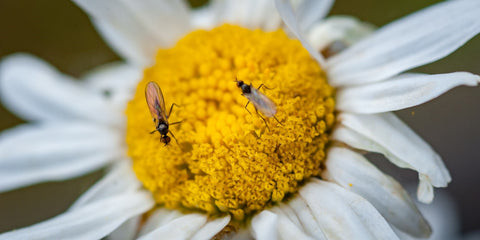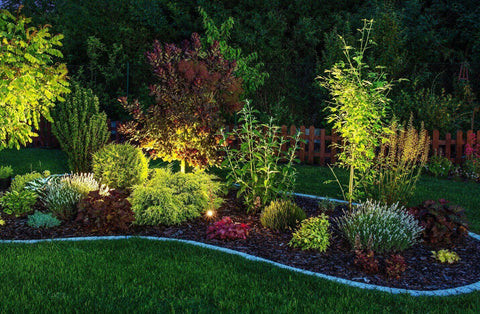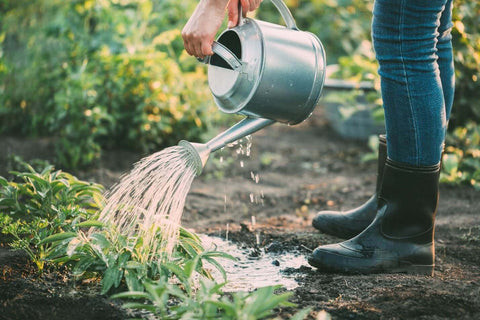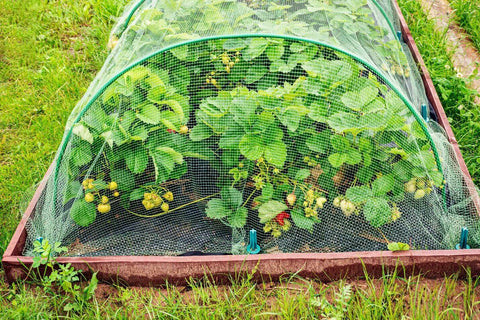Keeping flies out of your garden is essential for protecting your plants and enjoying your outdoor space, and Flyermedia.net is here to provide you with tips and solutions. This comprehensive guide covers everything from identifying fly infestations to implementing preventative measures, ensuring your garden remains a healthy and enjoyable environment with effective fly control and eco-friendly solutions. You’ll discover effective strategies for pest management, natural repellents, and maintaining a pristine garden environment.
1. Identifying Fly Presence in Your Garden
Detecting a fly problem early is crucial for preserving the health of your plants. So, how can you tell if you have a fly infestation? It’s important to look for adult flies, larvae, and eggs. Adult flies are often seen hovering around plants, while larvae and eggs are typically found in the soil. Fruit fly eggs are commonly laid on the surface of overripe fruit. Additionally, keep an eye out for signs of fly activity, such as the white lines or patches on leaves caused by leafminers, which are fly larvae that feed on plant leaves. Regularly inspecting your plants can help you catch infestations early and prevent significant damage.
1.1. Recognizing Adult Flies
Spotting adult flies is often the first sign of a potential problem in your garden. Adult flies are easily identifiable as they fly around plants.
1.2. Locating Larvae and Eggs
Larvae and eggs are commonly found in the soil. Inspecting the soil around your plants can help you identify these pests early. Fruit fly eggs are often laid on overripe or decaying fruit, so it’s important to remove any such produce from your garden.
1.3. Spotting Signs of Fly Activity
Leafminers, which are larvae of various fly species, live inside plant leaves, feeding on the tissue. This feeding often creates noticeable white lines or patches on the leaves. According to research from the University of California Agriculture and Natural Resources, leafminers can cause significant aesthetic damage to plants and reduce their photosynthetic capacity.
 Fungus gnats on flower
Fungus gnats on flower
2. Maintaining a Clean Garden and Yard
A tidy garden and yard are key to preventing fly infestations. What steps can you take to keep your outdoor space clean and fly-free? Regularly remove overripe or fallen fruit to discourage fruit flies. Fungus gnats are attracted to organic matter, so clear away fallen leaves and flowers. Also, ensure that you clean up any trash or debris that could attract adult flies. Keeping your garden clean deprives flies of breeding and feeding grounds, significantly reducing their presence.
2.1. Removing Overripe Produce
Fruit flies are highly attracted to overripe or decaying fruits. Removing these from your garden helps to eliminate a primary food source, making your garden less appealing to these pests.
2.2. Clearing Organic Matter
Fungus gnats thrive in environments rich in organic matter. Regularly removing fallen leaves, flowers, and other decaying plant material reduces their breeding grounds, helping to control their population.
2.3. Managing Trash and Debris
Adult flies are attracted to trash and other forms of debris. Keeping your garden and yard free of these items helps to minimize their presence and prevents them from laying eggs nearby.
 Garden shrubs and plants
Garden shrubs and plants
3. Practicing Proper Watering Techniques
Proper watering is essential to avoid attracting flies to your garden. What’s the best way to water your plants without creating a fly-friendly environment? Flies are drawn to moisture, and fungus gnats especially flourish in damp soil. Avoid overwatering your plants and allow the top layer of soil to dry out between watering sessions. This practice helps prevent the soil from becoming overly wet, which attracts these unwanted pests.
3.1. Avoiding Overwatering
Overwatering creates the ideal conditions for fungus gnats to thrive. Allowing the topsoil to dry out between watering helps reduce the moisture that attracts these pests.
3.2. Allowing Soil to Dry
Letting the top layer of soil dry out not only discourages flies but also promotes healthier root growth for your plants. Dry soil makes the environment less hospitable for fly larvae.
3.3. Utilizing Efficient Watering Systems
Consider using drip irrigation or soaker hoses to deliver water directly to the roots of your plants. This method minimizes surface moisture, reducing the attraction for flies and preventing the soil from becoming waterlogged. According to the Food and Agriculture Organization of the United Nations, efficient irrigation systems can reduce water usage by up to 50% compared to traditional methods.
 Watering plants
Watering plants
4. Protecting Plants with Physical Barriers
Physical barriers provide a straightforward method to keep flies away from your plants. What physical barriers can you use to protect your garden? Row covers are an effective option. These covers are designed to sit directly over your plants, allowing light and moisture to penetrate while preventing pests from reaching them. You can purchase row covers or even create your own. These barriers offer a safe and effective way to protect your plants without the use of chemicals.
4.1. Using Row Covers
Row covers are thin screens that provide a physical barrier against flies and other pests. They allow sunlight and water to reach the plants while preventing insects from landing on them.
4.2. Constructing DIY Covers
Creating your own plant covers can be a cost-effective solution. Using materials like cheesecloth or fine mesh, you can build simple covers that protect your plants from flies while allowing them to breathe.
4.3. Implementing Plant Netting
Plant netting is another excellent option for creating a physical barrier. This lightweight mesh can be draped over plants to keep flies out, ensuring they cannot lay eggs or feed on the foliage. According to the Royal Horticultural Society, netting is particularly effective for protecting vulnerable crops like berries and leafy greens.
 Row cover
Row cover
5. Planting Fly-Repelling Plants
Certain plants naturally repel flies with their fragrances. Which plants can you include in your garden to deter flies? Basil, rosemary, lavender, and mint are known for their fly-repelling properties. Planting these around your garden can help keep flies away, as well as deter other garden pests.
5.1. Incorporating Basil
Basil is a popular herb known for its strong scent, which repels flies. Planting basil near your vegetable garden or in pots around your patio can help keep these pests away.
5.2. Using Rosemary
Rosemary is another effective fly repellent due to its pungent aroma. Rosemary is also drought-tolerant, making it a great addition to gardens in drier climates.
5.3. Adding Lavender
Lavender’s soothing fragrance is pleasant for humans but offensive to flies. Planting lavender along borders or in containers can help create a fly-free zone in your garden. According to a study published in the journal Environmental Entomology, lavender oil is an effective repellent against several species of flies.
5.4. Planting Mint
Mint is a versatile plant that repels flies and other insects. Its strong scent is particularly effective at keeping flies away. Be mindful of its rapid growth, and consider planting it in containers to prevent it from spreading aggressively.
 Mint
Mint
6. Employing Plant-Based Insecticide Sprays
Plant-based insecticide sprays offer a natural way to manage fly populations in your garden. How can you use these sprays effectively? Products like Flying Insect Killer are designed to eliminate flies and other flying insects. These sprays often provide residual repellency, creating a barrier that keeps pests away. Additionally, consider using a 3-in-1 Garden Spray to prevent and control insects, mites, and fungal diseases that can harm your plants.
6.1. Using Flying Insect Killer
Flying Insect Killer is designed to target flies and other flying insects. These products are often made from natural ingredients, providing a safe and effective solution for controlling fly populations in your garden.
6.2. Applying 3-in-1 Garden Spray
A 3-in-1 Garden Spray can protect your plants from insects, mites, and fungal diseases. This type of spray is useful for maintaining overall plant health and preventing infestations.
6.3. Exploring Neem Oil
Neem oil is a natural insecticide derived from the neem tree. It works by disrupting the life cycle of insects, preventing them from feeding and reproducing. According to the EPA, neem oil is considered safe for use around humans and pets when used as directed.
 Flying Insect Killer
Flying Insect Killer
7. Utilizing Natural Fly Traps
Natural fly traps are an effective way to reduce fly populations in your garden without using harmful chemicals. What types of natural traps can you use? One simple method involves using a mixture of apple cider vinegar and dish soap. The vinegar attracts the flies, while the soap breaks the surface tension of the liquid, causing them to drown. Another option is to use sticky fly paper, which traps flies as they land on it. These traps can be placed strategically around your garden to capture and eliminate flies.
7.1. Apple Cider Vinegar Traps
Apple cider vinegar is a natural attractant for flies. To create a trap, pour some apple cider vinegar into a jar and add a few drops of dish soap. The soap helps to trap the flies once they enter the jar.
7.2. Sticky Fly Paper
Sticky fly paper is a simple and effective way to trap flies. Hang the paper in areas where flies are common, and they will get stuck to the adhesive surface.
7.3. Sugar and Water Traps
A mixture of sugar and water can also be used to create an effective fly trap. Mix sugar with water and add a few drops of dish soap. The sweetness attracts flies, while the soap traps them. According to a study by the University of Florida, sugar-based traps are particularly effective for attracting and trapping fruit flies.
8. Introducing Beneficial Insects
Introducing beneficial insects to your garden can help control fly populations naturally. What insects are beneficial for fly control? Ladybugs, lacewings, and nematodes are all effective predators of flies and their larvae. Ladybugs and lacewings feed on fly eggs and larvae, while nematodes are microscopic worms that parasitize fly larvae in the soil. Releasing these beneficial insects into your garden can help maintain a balanced ecosystem and reduce the need for chemical interventions.
8.1. Releasing Ladybugs
Ladybugs are voracious predators of aphids and other small insects, including fly eggs and larvae. Releasing ladybugs into your garden can help control fly populations and keep your plants healthy.
8.2. Using Lacewings
Lacewings are another beneficial insect that feeds on fly eggs and larvae. Their larvae, known as aphid lions, are particularly effective predators.
8.3. Applying Nematodes
Nematodes are microscopic worms that parasitize various soil-dwelling insects, including fly larvae. Applying nematodes to the soil can help control fly populations at their larval stage. According to the USDA, nematodes are a safe and effective biological control method for many garden pests.
9. Improving Soil Health
Healthy soil is less attractive to flies and supports robust plant growth, making your garden more resilient to pests. What steps can you take to improve your soil’s health? Adding compost and other organic matter improves soil structure, drainage, and nutrient content. Well-draining soil is less likely to attract fungus gnats, as they prefer moist conditions. Additionally, healthy soil supports strong root systems, making plants more resistant to pests and diseases.
9.1. Adding Compost
Compost is an excellent soil amendment that improves soil structure, fertility, and drainage. Adding compost to your garden helps create a healthy environment that supports plant growth and deters pests.
9.2. Using Organic Matter
Organic matter, such as aged manure, leaf mold, and shredded bark, enriches the soil and improves its ability to retain moisture and nutrients. This creates a healthier growing environment for your plants and reduces the likelihood of fly infestations.
9.3. Ensuring Proper Drainage
Proper soil drainage is essential for preventing fungus gnats and other moisture-loving pests. Improving soil drainage helps keep the soil from becoming waterlogged, which attracts these pests. According to a study by the University of Minnesota Extension, well-drained soil is crucial for preventing many common plant diseases and pest problems.
10. Monitoring and Maintaining Your Garden
Regular monitoring and maintenance are crucial for preventing fly infestations. What does effective garden maintenance involve? Regularly inspect your plants for signs of flies and other pests. Remove any dead or decaying plant matter, as this can attract flies. Additionally, maintain proper watering practices and ensure that your soil is healthy. By consistently monitoring and maintaining your garden, you can catch problems early and prevent them from escalating.
10.1. Regularly Inspecting Plants
Regularly inspecting your plants for signs of flies and other pests allows you to catch infestations early and take prompt action. This helps prevent significant damage to your plants and keeps your garden healthy.
10.2. Removing Dead Plant Matter
Dead or decaying plant matter can attract flies and other pests. Removing this material from your garden helps eliminate breeding grounds and reduces the likelihood of infestations.
10.3. Adjusting Watering Practices
Adjusting your watering practices based on the weather and the needs of your plants can help prevent overwatering and reduce the attraction for flies. Monitor soil moisture levels and water only when necessary. According to the Texas A&M AgriLife Extension, adjusting watering practices can significantly reduce pest and disease problems in the garden.
11. Crop Rotation Strategies
Crop rotation is an effective method to disrupt the life cycle of pests and diseases, including flies. How does crop rotation work? By changing the location of different plant families each season, you can prevent the buildup of soilborne pests and diseases that target specific plants. This practice also helps improve soil health by balancing nutrient uptake. Rotating crops can reduce the need for chemical treatments and promote a healthier garden ecosystem.
11.1. Understanding Crop Families
Knowing which plant families are susceptible to similar pests and diseases is crucial for effective crop rotation. Grouping plants by family and rotating them helps break the cycle of infestation.
11.2. Planning Your Rotation
Plan your crop rotation to alternate between heavy feeders and soil-enriching crops. This helps maintain soil fertility and prevent the buildup of pests and diseases.
11.3. Implementing Long-Term Rotation
For best results, implement a long-term crop rotation plan that spans several seasons. This provides sustained benefits for soil health and pest control. According to the Rodale Institute, long-term crop rotation can significantly reduce the need for synthetic fertilizers and pesticides.
12. Companion Planting Techniques
Companion planting involves growing different plants together to benefit each other. How can companion planting help with fly control? Certain plants, when grown together, can repel flies or attract beneficial insects that prey on flies. For example, planting marigolds near tomatoes can help repel whiteflies, while planting dill near cabbage can attract predatory wasps that control cabbage worms. Companion planting can create a more balanced and resilient garden ecosystem.
12.1. Marigolds and Tomatoes
Marigolds are known for their ability to repel various pests, including whiteflies and nematodes. Planting marigolds near tomatoes can help protect them from these pests and promote healthier growth.
12.2. Dill and Cabbage
Dill attracts predatory wasps that prey on cabbage worms, protecting cabbage and other brassica crops from infestation. This combination creates a natural pest control system in the garden.
12.3. Basil and Tomatoes
Basil not only repels flies but also enhances the flavor of tomatoes. Planting basil near tomatoes can help keep pests away and improve the overall health and productivity of your tomato plants. According to research from Iowa State University, basil can also help deter aphids and other common tomato pests.
13. Creating a Fly-Repellent Garden Layout
The layout of your garden can also influence fly populations. How can you design your garden to minimize fly attraction? Avoid creating areas where water can pool, as these can become breeding grounds for flies. Ensure good air circulation to keep the soil dry and less attractive to fungus gnats. Additionally, group plants with similar watering needs to prevent overwatering in certain areas. A well-designed garden layout can help create an environment that is less hospitable to flies.
13.1. Ensuring Good Air Circulation
Good air circulation helps keep the soil dry and less attractive to fungus gnats. Space plants adequately to allow for airflow and prevent the buildup of moisture.
13.2. Avoiding Water Pooling
Areas where water can pool become breeding grounds for flies. Ensure proper drainage in your garden and avoid creating low spots where water can accumulate.
13.3. Grouping Plants by Watering Needs
Grouping plants with similar watering needs prevents overwatering in certain areas. This helps maintain a consistent moisture level in the soil and reduces the attraction for flies. According to the University of California Cooperative Extension, grouping plants by watering needs is a key practice for water conservation and pest management in the garden.
14. Addressing Common Fly-Related Problems
Various fly-related problems can affect your garden, each requiring specific solutions. What are some common fly-related issues and how can you address them? Fungus gnats are a common problem in overly moist soil, while fruit flies are attracted to overripe or decaying fruit. Leafminers can cause damage to plant leaves, and shore flies can indicate poor water quality. Identifying the specific fly issue and implementing targeted solutions is crucial for effective control.
14.1. Fungus Gnats
Fungus gnats are small, dark flies that thrive in moist soil. To control them, allow the top layer of soil to dry out between waterings, and consider using yellow sticky traps to capture adults.
14.2. Fruit Flies
Fruit flies are attracted to overripe or decaying fruit. Remove any fallen fruit from your garden and use apple cider vinegar traps to capture adults.
14.3. Leafminers
Leafminers cause white lines or patches on plant leaves. Remove and destroy infested leaves, and consider using row covers to prevent adult flies from laying eggs on your plants.
14.4. Shore Flies
Shore flies indicate poor water quality and often appear in gardens with algae growth. Improve water circulation and drainage to reduce algae growth, and consider using beneficial nematodes to control larvae. According to Penn State Extension, addressing the underlying cause of shore fly infestations is crucial for long-term control.
15. Monitoring Weather Conditions
Weather conditions can significantly impact fly populations. How does weather affect fly infestations? Warm, moist weather provides ideal conditions for fly breeding, while dry weather can help reduce populations. Monitoring weather patterns and adjusting your garden practices accordingly can help prevent fly infestations. For example, during periods of heavy rain, ensure good drainage and avoid overwatering your plants.
15.1. Adjusting Practices for Rain
During periods of heavy rain, ensure good drainage in your garden to prevent waterlogging. Adjust your watering practices to avoid overwatering, and consider using row covers to protect plants from excess moisture.
15.2. Adapting to Dry Spells
During dry spells, ensure that your plants receive adequate water, but avoid overwatering. Use mulch to help retain moisture in the soil, and consider using drought-tolerant plants that require less water.
15.3. Preparing for Warm Weather
Warm weather provides ideal conditions for fly breeding. Monitor your garden closely for signs of infestation, and implement preventative measures such as using fly traps and applying plant-based insecticides. According to the National Weather Service, monitoring weather conditions can help gardeners anticipate and manage pest problems more effectively.
With these tips, you can effectively manage fly populations in your garden and maintain a healthy, thriving outdoor space.
Are you eager to discover more about effective pest control and maintaining a thriving garden? Visit flyermedia.net today for a wealth of information, including expert tips on pest management, insights into the latest agricultural technologies, and comprehensive guides for gardeners of all levels. Explore our resources and take the first step towards a healthier, more productive garden now!
FAQ: Keeping Flies Out of Your Garden
1. What attracts flies to gardens?
Flies are attracted to gardens by several factors, including overripe fruit, decaying organic matter, moist soil, and standing water. These conditions provide food and breeding grounds for various types of flies, such as fruit flies and fungus gnats.
2. How do I identify a fly infestation in my garden?
Signs of a fly infestation include seeing adult flies hovering around plants, finding larvae in the soil, noticing eggs on overripe fruit, and observing damage to plant leaves, such as the white lines caused by leafminers.
3. What are natural ways to repel flies from my garden?
Natural ways to repel flies include planting fly-repelling plants like basil, rosemary, lavender, and mint. You can also use natural fly traps, such as apple cider vinegar traps, and introduce beneficial insects like ladybugs and lacewings.
4. How can I prevent fungus gnats in my garden?
To prevent fungus gnats, avoid overwatering your plants and allow the top layer of soil to dry out between waterings. Improve soil drainage by adding compost and organic matter. You can also use yellow sticky traps to capture adult gnats.
5. Are plant-based insecticides effective for controlling flies?
Yes, plant-based insecticides can be effective for controlling flies. Products like Flying Insect Killer and 3-in-1 Garden Spray are designed to target flies and other pests while being safer for the environment and your family.
6. What is the role of crop rotation in fly control?
Crop rotation helps disrupt the life cycle of pests, including flies, by preventing the buildup of soilborne pests and diseases. Changing the location of different plant families each season can reduce the need for chemical treatments.
7. How does companion planting help with fly control?
Companion planting involves growing different plants together to benefit each other. Certain plants, like marigolds and basil, can repel flies or attract beneficial insects that prey on flies, creating a more balanced garden ecosystem.
8. What impact does weather have on fly populations in gardens?
Weather conditions significantly impact fly populations. Warm, moist weather provides ideal conditions for fly breeding, while dry weather can help reduce populations. Adjusting your garden practices based on weather patterns can help prevent infestations.
9. How can I improve soil health to deter flies?
Improving soil health involves adding compost and organic matter to improve soil structure, drainage, and nutrient content. Well-draining soil is less attractive to fungus gnats, and healthy soil supports strong plant growth, making plants more resistant to pests and diseases.
10. What are some common fly-related problems in gardens and how can I address them?
Common fly-related problems include fungus gnats, fruit flies, leafminers, and shore flies. Addressing these issues involves implementing targeted solutions, such as adjusting watering practices, removing overripe fruit, and improving water quality. Regular monitoring and maintenance are crucial for preventing and managing these problems effectively.